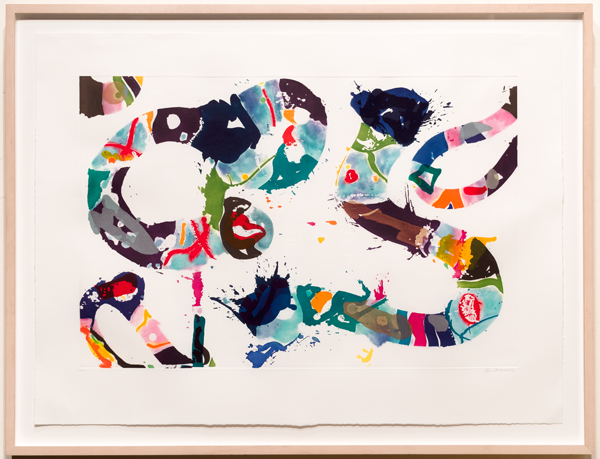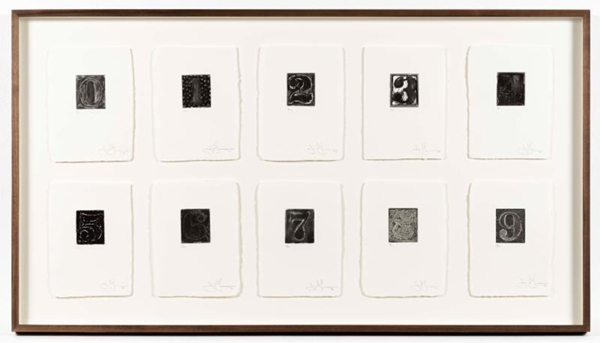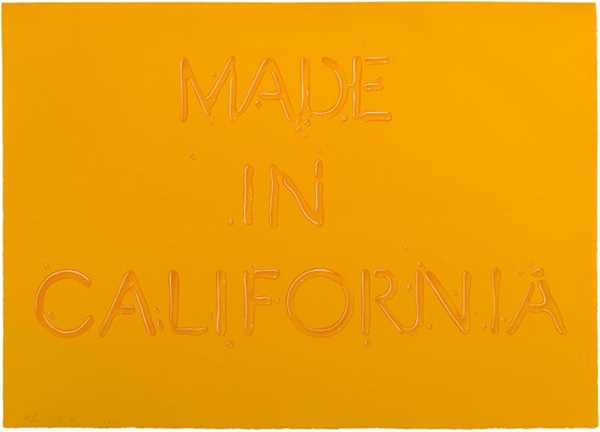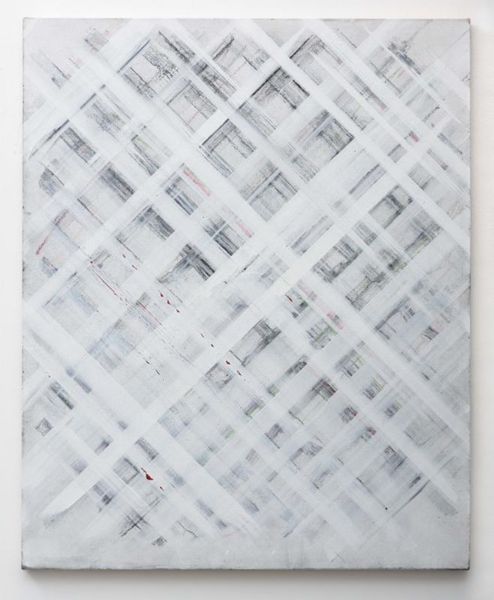"Friday Feature"
Sam Francis, Jasper Johns, Ed Ruscha, Ed Moses

Leslie Sacks Contemporary
Bergamot Station 2525 Michigan Avenue, B6 Santa Monica, California 90404T: (310) 264-0640 F: (310) 264-0740 e-mail:
1 > 30 April, 2017

Sam Francis, Untitled, 1993, aquatint, 32 x 43 inches, edition of 21, signed and numbered
Francis's art is marked by a singular spirit of exploration: a quest for making, recognizing, finding essential forms, lines, rhythms, colors. Regardless of medium, the artist reveals a consummate unity with process; and printmaking, which requires a circuitous approach to developing an image, appears to be as intuitive and direct for him as painting. "What has happened," he has said of his monotypes, "is that I have found a way to get into that machine [the printing press]...When I am working with these prints, I am the paper, I am the paint, I am the machine..I am not trying to 'make something.'"
-Ruth E. Fine, The Prints of Sam Francis: A Catalogue Raisonné
Volume I, Hudson Hills Press, New York, 1992, page 15
View additional works by Sam Francis
-Ruth E. Fine, The Prints of Sam Francis: A Catalogue Raisonné
Volume I, Hudson Hills Press, New York, 1992, page 15
View additional works by Sam Francis

Jasper Johns, 0-9, 1975, complete suite of 10 etchings Each sheet: 8 3/8 x 6 inches, overall framed: 23 3/8 x 41 5/8 inches Edition of 100, each signed and numbered
Although Johns uses the same motifs again and again, he is incapable of doing the same painting more than once. Also, his lithographs of the flags, targets, numbers and letters in no way resemble reproductions. First of all, the technique is completely different and limits him to transpositions, variations and adaptations. Secondly, Johns fully exploits and delights in the medium's specificities, and the work that comes off the stone or zinc plate is entirely original. Collectors value these infinite variations as new alternatives to the painted work, and they prove just as rich in a sensitivity that is revealed in many different ways.
--Georges Boudaille, Jasper Johns: The Graphics, Rizzoli, New York, 1989, page 22-23
View additional works by Jasper Johns
--Georges Boudaille, Jasper Johns: The Graphics, Rizzoli, New York, 1989, page 22-23
View additional works by Jasper Johns

Ed Ruscha, Made in California, 1971, lithograph 20 x 28 1/16 inches, edition of 100, signed and numbered
If he hadn't already done so with his paintings, Ruscha revealed himself with the prints of the late 1960s and early 1970s to be an extraordinary colorist, one who was open to the interpretive possibilities available with ink and the printed surface. Anchovy was glossed with a film of pearlescent ink, imparting to the blue-gray surface the silvery look of a fish. The ink for Made in California was matched perfectly to a glass of fresh-squeezed orange juice, and Mint was executed in peppermint pink. The richness of color and attention to surface in both the Tamarind and Cirrus works of the period confirmed that Ruscha's prints were as painterly as were his works in any medium.
--Siri Engberg and Clive Phillpot, Edward Ruscha: Editions 1959-1999, Catalogue Raisonné
Volume 2, Walker Art Center, Distributed Art Publishers, NY, 1999, page 32View additional works by Ed Ruscha
--Siri Engberg and Clive Phillpot, Edward Ruscha: Editions 1959-1999, Catalogue Raisonné
Volume 2, Walker Art Center, Distributed Art Publishers, NY, 1999, page 32View additional works by Ed Ruscha

Ed Moses, White Grid, 2015, acrylic on canvas, 52 x 42 inches
There are some big resin paintings that I did based on Navajo blankets. They were first grid paintings and then diagonal paintings. The artist Tony Berlant had introduced Navajo blankets to me, and to our circle of friends associated with Ferus Gallery. I stretched canvas and put strips of wood at the edges, and used a carpenter plumb-bob to make lines. You pull the string out and snap it and it instantly makes a line, which I found magical. Then I put masking tape in different places to make "lazy lines," which are also part of the blankets - the places where the thread goes off the warp or weft. I lived in New Mexico for a while to look at all of these sources...I also did drawings on vellum, some of which were based on Navajo chief blankets. I was interested in making delineations of patterns. I wasn't interested in the space, but they became very pictorial; people always commented on that. The pictorial space was a byproduct of the activity, and I do like that idea that you do it for one reason and something else results. Often, when I am working on a series of paintings, I am going in one direction, and out on the edge something flutters. I say, "Yeah I see you. I'm going to finish this now, but I'll come back to you." That thing flashes in the corner again, and after about three or four times, I give in. That is when one series ends and a new one begins.
-Ed Moses interviewed by Jennifer Samet, Beer with a Painter, LA Edition: Ed Moses, Hyperallergic, July 25, 2015
View additional works by Ed Moses
-Ed Moses interviewed by Jennifer Samet, Beer with a Painter, LA Edition: Ed Moses, Hyperallergic, July 25, 2015
View additional works by Ed Moses



 Sam Francis |
 Jasper Johns |
 Ed Ruscha |
 Ed Moses |







